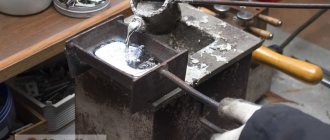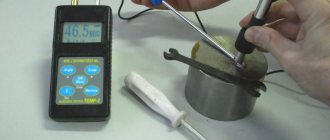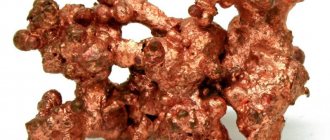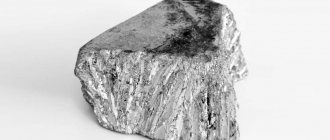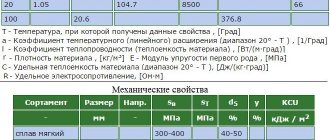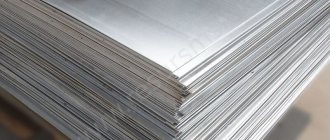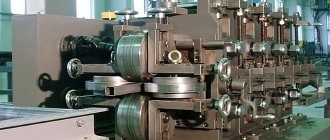Despite its name - “resistant”, tin is not a durable metal. It is too light and malleable to be used for the production of any load-bearing structures. But malleability at relatively low temperatures and plasticity make the substance very popular in the relevant field. You will learn all this and even more from this article about how you can use tin, where to buy it for soldering, what solders are possible with it.
History of discovery
Before talking about the production of the alloy, you need to understand where its main components came from. Based on archaeological finds, historians have established that lead first appeared 6 thousand years ago. It was contained in silver ores.
The noble metal was used to make jewelry, dishes, and cutlery. Lead was considered a waste product and therefore was not used. However, gradually people noticed the properties of this material. Today it is used in production:
- alloys;
- batteries;
- structures protecting against radioactive radiation;
- coloring compositions, solders for radio electronics;
- protective sheath for wires.
This material is used in the automotive industry.
Tin appeared about 3500 years ago. It was originally used to make cutlery. In modern industry, this material is used to create cans. This began in 1810, when people learned to store food using metal containers. Tin is used in the manufacture of radiators for cars and bearings.
Tin is often used to make parts for industrial equipment. This is due to its increased hardness and strength. Compounds of this metal with lead are used to create bearings, since the mixture is considered wear-resistant.
Historical reference.
Tin was probably used back in the days of Homer and Moses. Its discovery was most likely associated with the accidental recovery of alluvial cassiterite (tin stone); alluvial deposits occur at or near the surface, and tin ores are much more easily reduced than ores of other metals. The ancient Britons were well acquainted with tin: ancient forges containing slag were discovered in Cornwall in southwest England. Metal was obviously inaccessible and expensive, because... Tin objects are rare among Roman and Greek antiquities, although tin is mentioned in the Bible in the Fourth Book of Moses (Numbers), and the word cassiterite, which is still used today to designate the oxide tin ore, is of Greek origin. Malacca and East India are mentioned as sources of tin in Arabic literature of the 8th–9th centuries. and various authors in the 16th century. in connection with the Great Geographical Discoveries. The history of tin mining in Saxony and Bohemia dates back to the 12th century, but in the 17th century. The 30 Years' War (1618–1648) destroyed this industry. Production was subsequently resumed, but soon declined due to the discovery of rich deposits in America.
Composition and structure
Compounds often contain not only two main components, but also alloying additives. The main one is antimony. The compound may contain up to 15% of this substance. Other alloying additives are silver, cadmium and bismuth. Silver and antimony act in the same way. They are added when it is necessary to increase the melting temperature of the material. If it is necessary to make the mixture less refractory, it is saturated with bismuth and cadmium.
When it is necessary to create a wear-resistant material that will withstand constant friction, the mixture is supplemented with copper. Due to the variety of alloying additives that can be used in the production of tin and lead alloys, the compounds are used in various industrial areas.
Melting alloy
Where is it used?
Metal is in demand as an independent material, in alloys and compounds.
Its chemical and physical properties make it possible to produce safe, rust-resistant products and coatings.
Tin soldier in mold after casting
Metal
Pure metal is in demand as:
- Containers of food products.
- Packaging foil.
- Anode in chemical current sources.
It is also a coating for copper wires. The metal protects the copper “filling” from the harmful effects of sulfur contained in the insulating material.
Tin cup from Gdansk (Poland)
Tin is the most environmentally friendly of light non-ferrous metals.
Connections
Metal compounds have found application in various segments of the economic complex:
- Aviation and mechanical engineering . Additive in titanium alloys.
- Electrical engineering. Superconducting wire (niobium compound).
- Optics. Abrasive for finishing glass surfaces.
- Light industry . Yellow dye for wool.
- Agriculture . Pesticides.
- Decor. Component of “golden” paints.
Isomers of artificial origin are used in medicine as a source of gamma radiation.
A third of the mined tin is used to make tableware. Another 60% is taken by bearings, packaging foil, and solders. Less than 7% remains for other purposes.
Prospects
The potential of two-dimensional tin layers created using graphene technology is being explored. The name of the material is consonant with its “parent” – stanen.
Properties and markings
Finished alloys based on tin and lead have a number of properties that make the compound unique:
- Melting point - up to 500 degrees Celsius, depending on the percentage of alloying additives.
- High wear resistance.
- Oxidation resistance is higher than that of pure materials.
There are two types of lead compounds: babbitts and solders. The first ones are designated by the letter “B”. Next, the letters of the alloying additives, the percentage of the main substance, and the number of additional components are indicated.
Advantages and disadvantages
The advantages of tin lie in the following characteristics of the metal:
- high corrosion resistance, as well as immunity to salts and a number of organic acids;
- in the inability to react with sulfur, which may be contained in other materials (this allows you to combine tin and, for example, plastic in the same products);
- in the absence of toxicity - a quality that allows the use of Sn in the food industry.
Tin is characterized by the following disadvantages:
- low temperature of transition to the liquid state;
- susceptibility to the “tin plague”.
Classification
Particularly common are alloys of tin and lead, called babbitts. They can be divided into several groups:
- Tin - designated as B83, B89. Contains antimony and lead. Tin acts as a base. Used in the manufacture of bearings for industrial equipment. However, the base metal is considered expensive, so cheaper analogues are often used.
- Lead - designated as B16. Lead-based alloys are considered more advantageous analogues of tin compounds. Their high wear resistance allows them to be used to make parts for machine tools and moving mechanisms.
- Calcium - solid particles that make up this alloy are a compound of calcium and lead. Tin acts as an additional component.
Tin brands
Metallurgists smelt several grades of metal:
| Brand | Amount of impurities (%) |
| OVCh-000 | 0,001 |
| O1pch | 0,085 |
| O1 | 0,010 |
| O2 | 0,435 |
| O3 | 1,51 |
| O4 | 3,51 |
The first four grades of tin are produced in the form of ingots, wire, and rods. Pigs are smelted from O3 and O4. This is the source code for tin products.
Areas of application
Tin alloys were previously used to make dishes and cutlery. Nowadays they are much more often used to create cans. From this material, in combination with other components, solders are made, which come in several types:
- Low-melting - melting point does not exceed 150 degrees Celsius.
- Medium melting - become liquid when heated from 200 to 500 degrees.
- Refractory - melts at temperatures above 1100 degrees.
Another area of application for alloys is the production of friction-resistant parts.
Tin-lead solder
Physico-chemical characteristics
Metal is endowed with many advantages: ductile, lightweight, malleable, non-toxic.
Chemical properties do not appear at ordinary temperatures.
| Properties of the atom | |
| Name, symbol, number | Tin / Stannum (Sn), 50 |
| Atomic mass (molar mass) | 118.710(7) a. e.m. (g/mol) |
| Electronic configuration | [Kr] 4d10 5s2 5p2 |
| Atomic radius | 162 pm |
| Chemical properties | |
| Covalent radius | 141 pm |
| Ion radius | (+4e) 71 (+2) 93 pm |
| Electronegativity | 1.96 (Pauling scale) |
| Electrode potential | −0,136 |
| Oxidation states | +4, +2 |
| Ionization energy (first electron) | 708.2 (7.34) kJ/mol (eV) |
| Thermodynamic properties of a simple substance | |
| Density (at normal conditions) | 7.31 g/cm³ |
| Melting temperature | 231.91 °C |
| Boiling temperature | 2893 K, 2620 °C |
| Ud. heat of fusion | 7.19; kJ/mol |
| Ud. heat of vaporization | 296 kJ/mol |
| Molar heat capacity | 27.11 J/(K mol) |
| Molar volume | 16.3 cm³/mol |
| Crystal lattice of a simple substance | |
| Lattice structure | tetragonal |
| Lattice parameters | a=5.831; c=3.181 Å |
| c/a ratio | 0,546 |
| Debye temperature | 170.00 K |
Disadvantages: low melting point, vulnerability to the “tin plague”.
Features of production and processing
Consumable raw materials are obtained from ore. For example, to obtain 1 kilogram of pure material, it is necessary to process 100 kg of ore. Both materials melt at low temperatures. To manufacture the alloy, the following features must be taken into account:
- When making a casting mold, you must use a material that is not susceptible to wetting by molten consumable metals.
- The mold must withstand heating at temperatures above 250 degrees.
- Molten metals quickly oxidize when exposed to the environment. Solid metal is protected from oxidation.
When it comes to making solder, antimony is added to the compound. Some craftsmen add silver. It has the following features:
- Silver protects the material from rust formation.
- Due to the addition of noble metal, the price tag for finished solder increases, but its functionality expands.
There are solders with added zinc. However, they are rarely used. Zinc actively reacts to environmental factors. It begins to collapse, which leads to a violation of the integrity of the product. It is better to use a mixture of antimony, tin and lead. This solder is used to solder radio components, contacts, and wires. By changing components, craftsmen achieve the desired characteristics from a consumable. We must not forget about the use of flux.
The alloy of tin and lead has special characteristics. They change after adding alloying components. Ready-made compounds are used for the manufacture of solders, wear-resistant parts, dishes, cutlery, and cans.
"Tin Plague"
Under normal pressure, the metal takes one of two modifications:
- α-Sn. Temperature less than +13.2°C. Dull gray powder (tin gray).
- β-Sn. Temperature above +13.2°C. Metal, white tin.
Gray and white tin
At air temperatures below +13.2°C, β-tin is reformatted into the α-modification. The structure of the lattice changes, the silver metal becomes a gray powder.
The process proceeds fastest at -33°C. Because of its speed, it was dubbed the “tin plague.” It destroyed Napoleon's army during his campaign in Russia and many museum exhibits when the premises froze.
Connections.
Tin forms a variety of chemical compounds, many of which have important industrial applications. In addition to numerous inorganic compounds, the tin atom is capable of forming a chemical bond with carbon, which allows the production of organometallic compounds known as organotin compounds (see also ORGANOMETALLIC COMPOUNDS). Aqueous solutions of tin chlorides, sulfates and fluoroborates serve as electrolytes for the precipitation of tin and its alloys. Tin oxide is used in ceramic glazes; it gives the glaze opacity and serves as a coloring pigment. Tin oxide can also be deposited from solutions as a thin film on various products, which adds strength to glass products (or reduces the weight of vessels while maintaining their strength). The introduction of zinc stannate and other tin derivatives into plastic and synthetic materials reduces their flammability and prevents the formation of toxic smoke, and this area of application becomes the most important for tin compounds. A huge amount of organotin compounds are used as stabilizers for polyvinyl chloride, a substance used to make containers, pipelines, transparent roofing material, window frames, gutters, etc. Other organotin compounds are used as agricultural chemicals, for making paints and preserving wood.
